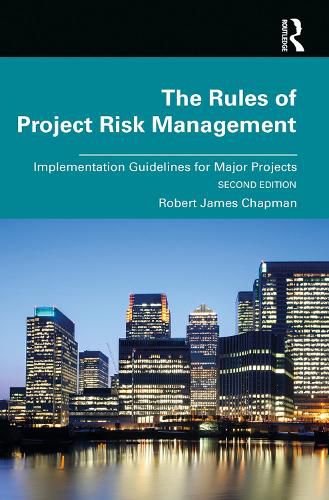Readings Newsletter
Become a Readings Member to make your shopping experience even easier.
Sign in or sign up for free!
You’re not far away from qualifying for FREE standard shipping within Australia
You’ve qualified for FREE standard shipping within Australia
The cart is loading…






The Rules of Project Risk Management, 2nd Edition, provides practical experience-based guidance to support the delivery of effective project risk management. While the discipline is recognised as a major contributor to the successful outcome of projects, its implementation is far from straightforward. Successful delivery requires an in-depth understanding of the ingredients of effective risk management practices which impact project performance. The book’s value is derived from the description of these ingredients in a manner which will support their practical implementation.
The author describes a series of guidelines (labelled rules ) to support the practical application of project risk management to positively influence project outcomes. The rules are supported by mini case studies of both successful and unsuccessful projects to bring to life the ramifications of effective and poor risk management respectively, and are assembled under seven headings of environment, external stakeholders, organisation and culture, leadership and governance, internal stakeholders, risk resources and system. This second edition contains a new glossary of terms and an overview of the risk management process to enable those new to the subject to understand the core risk management activities. It also contains six more individual guidelines and ten more case studies to support practitioners, researchers and academics alike to gain an even greater appreciation of the drivers of successful project risk management.
Enabling the reader to get inside risk management to gain an appreciation of the individual components and how the engine works , this book is essential reading for project and risk management professionals. While the guidelines are described individually so specific subjects can be examined in detail, they must be considered together, for like a car, specialist carburettors, fuel injection or high-octane fuel on their own do not support improved performance. The guidelines can be considered as the elements that should be taken into account when compiling a risk maturity model to drive incremental improvement in risk management practices.
$9.00 standard shipping within Australia
FREE standard shipping within Australia for orders over $100.00
Express & International shipping calculated at checkout
The Rules of Project Risk Management, 2nd Edition, provides practical experience-based guidance to support the delivery of effective project risk management. While the discipline is recognised as a major contributor to the successful outcome of projects, its implementation is far from straightforward. Successful delivery requires an in-depth understanding of the ingredients of effective risk management practices which impact project performance. The book’s value is derived from the description of these ingredients in a manner which will support their practical implementation.
The author describes a series of guidelines (labelled rules ) to support the practical application of project risk management to positively influence project outcomes. The rules are supported by mini case studies of both successful and unsuccessful projects to bring to life the ramifications of effective and poor risk management respectively, and are assembled under seven headings of environment, external stakeholders, organisation and culture, leadership and governance, internal stakeholders, risk resources and system. This second edition contains a new glossary of terms and an overview of the risk management process to enable those new to the subject to understand the core risk management activities. It also contains six more individual guidelines and ten more case studies to support practitioners, researchers and academics alike to gain an even greater appreciation of the drivers of successful project risk management.
Enabling the reader to get inside risk management to gain an appreciation of the individual components and how the engine works , this book is essential reading for project and risk management professionals. While the guidelines are described individually so specific subjects can be examined in detail, they must be considered together, for like a car, specialist carburettors, fuel injection or high-octane fuel on their own do not support improved performance. The guidelines can be considered as the elements that should be taken into account when compiling a risk maturity model to drive incremental improvement in risk management practices.